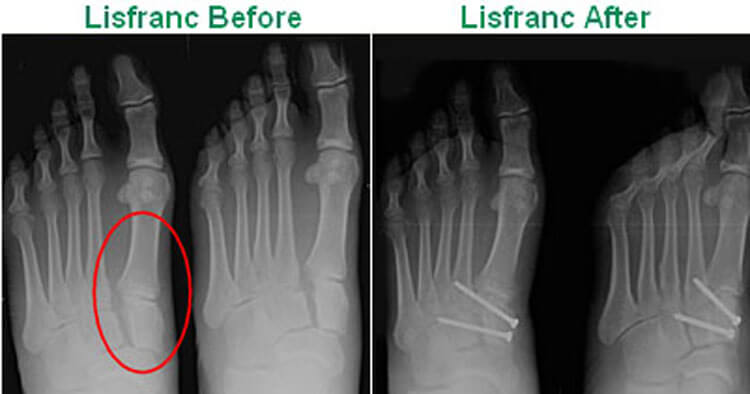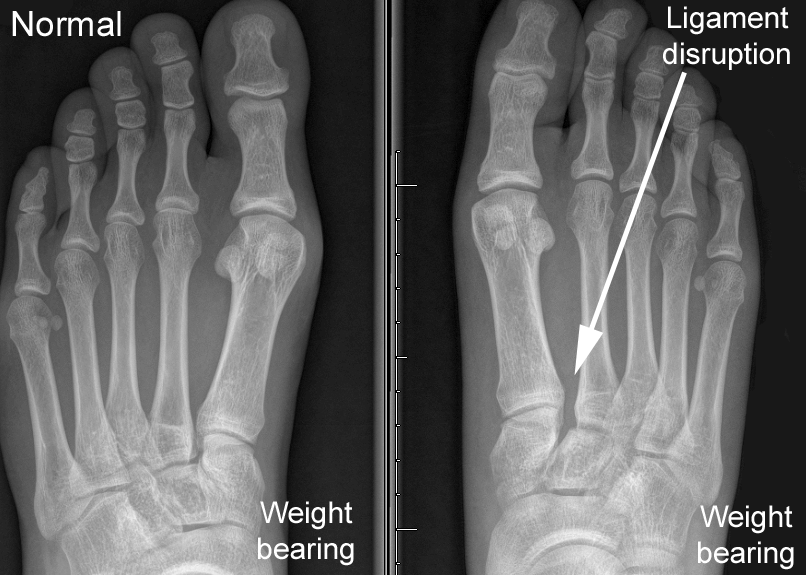Sports Injuries and Management
Diagnosis Of A TMT Joint Injury
Assessment Of A TMT Joint Injury
Assessment Signs And Tests That Can Indicate TMT Joint Injury:
- Tenderness to palpation of the midfoot when pressure is applied to the area.
- Bruising along the bottom of the foot following appropriate injury is considered a strong indicator of a Lisfranc injury.
- Pain with a manual stress examination of the midfoot.
- Pain with a stress examination test to the midfoot known as the “piano key” test. The piano key test specifically puts stress across the midfoot and will generally produce pain if there is a TMT joint injury. In more significant injuries this test may also elicit signs of instability and the medical practitioner assessing may be able to pick up signs of laxity with extra movement “paly” with the test on the injured side compared to the uninjured foot.
- Single leg heel raise. When asked to stand on one foot (going on to tip toes) significant stress is placed across the midfoot, this test will generally cause pain if there is a TMT joint injury and for individuals with more significant injury may find it impossible to perform due to pain, or instability of their Lisfranc complex/midfoot.
Investigations Used To Help Diagnose A TMT Joint Injury
A plain X-ray can visualize the alignment of the Lisfranc joint, assessing to pick up any deviation in the normal joint alignment when compared to the unaffected side. If a change in joint alignment when compared to the uninjured foot is present it suggests injury to the ligaments of the midfoot. In low energy sporting injuries for example there may not be any fractures and only damage to the soft tissue supportive structures of the TMT joint has occurred. In this situation taking a weight bearing X-ray is ideal for visualizing the alignment “under load”, that is if standing on the injured foot can be tolerated. A weight bearing X-ray is the preferred choice for taking an X-ray if ligament disruption is suspected. With Lisfranc injury X-rays may visualize fractures even in non-weight bearing, however to assess ligament function of the midfoot weight bearing on the foot is best as injured soft tissues like ligaments are not visualized on X-ray. Weight bearing can therefore assess the ligaments ability to maintain foot alignment, highlighting the continuity of the foot arches even though the ligaments themselves are not visualized, see the image below.
With high energy injuries such as those sustained in a motor vehicle accident, X-rays are also useful, as they can also pick up fractures at the TMT Joint complex. These injuries can be a Lisfranc fracture-dislocation involving multiple joints and including multiple fractures of the area.
CT And MRI Imaging For Lisfranc Injury
The use of Magnetic resonance imaging (MRI) to visualize the soft tissues injured in a TMT joint injury is a useful investigation. However these investigations aren’t always necessary to diagnose a midfoot injury, although they are often used if standard X-rays are inconclusive and TMT injury is suspected. Similarly CT imaging (Computerized Tomography Scan) can be used where X-ray has failed to conclusively rule in, or out bony injury to the midfoot. CT imaging is more detailed than a standard X-ray, creating cross-section images of the foot meaning examination via CT imaging may show previously undetected fractures missed by X-ray. Yet again like MRI a CT is not always necessary to correctly diagnose a Lisfranc injury but both can provide very useful information to the treating medical practitioner.
The orthopaedic surgeon in charge of your care will order the necessary investigations, most likely where possible a weight bearing X ray will be ordered and then a MRI, or CT scan as deemed necessary depending on the results of the X-rays. Your surgeons management strategy will be based on the severity of the injury, for which the benefit of medial imaging is undeniable.
Disclaimer: Sydney Physio Clinic provides this information as an educational service and is not intended to serve as medical advice. Anyone seeking specific advice or assistance on Diagnosis And Treatment Of TMT Joint Injury should consult his or her physiotherapist, general practitioner, sports medicine specialist or orthopaedic surgeon.



